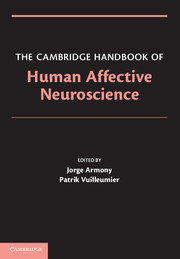
-
Select format
-
- Publisher:
- Cambridge University Press
- Publication date:
- February 2013
- January 2013
- ISBN:
- 9780511843716
- Dimensions:
- Weight & Pages:
- Dimensions:
- Weight & Pages:
You may already have access via personal or institutional login- Collection:
- Cambridge Handbooks of Psychology
Book description
Neuroscientific research on emotion has developed dramatically over the past decade. The cognitive neuroscience of human emotion, which has emerged as the new and thriving area of 'affective neuroscience', is rapidly rendering existing overviews of the field obsolete. This handbook provides a comprehensive, up-to-date and authoritative survey of knowledge and topics investigated in this cutting-edge field. It covers a range of topics, from face and voice perception to pain and music, as well as social behaviors and decision making. The book considers and interrogates multiple research methods, among them brain imaging and physiology measurements, as well as methods used to evaluate behavior and genetics. Editors Jorge Armony and Patrik Vuilleumier have enlisted well-known and active researchers from more than twenty institutions across three continents, bringing geographic as well as methodological breadth to the collection. This timely volume will become a key reference work for researchers and students in the growing field of neuroscience.
Reviews
"This edited volume provides a welcome up-to-date review of current Literature in the neuroscience of emotion.... Twenty eight-chapters authored by established experts provide coverage that is both broad and deep.... Chapters are well organized into sections that help the reader find relevant information quickly.... The focus on human emotion, rather than on nonhuman models of affect, gives the book a necessary focus while still covering plenty of ground. True to the field, the chapters represent findings from a wide range of methodological techniques.... It can also serve as a useful companion to the other valuable handbooks about emotion that are not as neuroscience oriented.... Highly recommended..."
--R. Compton, Haverford College, CHOICE
Contents
Metrics
Altmetric attention score
Full text views
Full text views help Loading metrics...
Loading metrics...
* Views captured on Cambridge Core between #date#. This data will be updated every 24 hours.
Usage data cannot currently be displayed.
Accessibility standard: Unknown
Why this information is here
This section outlines the accessibility features of this content - including support for screen readers, full keyboard navigation and high-contrast display options. This may not be relevant for you.
Accessibility Information
Accessibility compliance for the PDF of this book is currently unknown and may be updated in the future.


